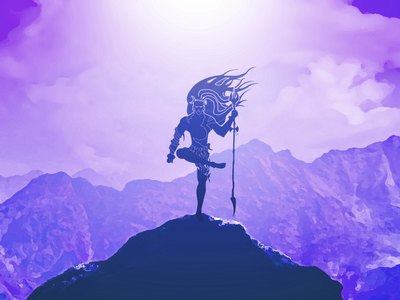Shiva is 'shakti' or power, Shiva is the destroyer, the most powerful god of the Hindu pantheon and one of the godheads in the Hindu Trinity. Known by many names - Mahadeva, Mahayogi, Pashupati, Nataraja, Bhairava, Vishwanath, Bhava, Bhole Nath - Lord Shiva is perhaps the most complex of Hindu deities. Hindus recognize this by putting his shrine in the temple separate from those of other deities.
Shiva As Phallic Symbol:
Shiva, in temples is usually found as a phallic symbol of the 'linga', which represents the energies necessary for life on both the microcosmic and the macrocosmic levels, that is, the world in which we live and the world which constitutes the whole of the universe. In a Shaivite temple, the 'linga' is placed in the center underneath the spire, where it symbolizes the naval of the earth.
There are a number of mythological tales and legends surroundingLord Shiva. Here're a few popular ones:
Ganga Comes Down to Earth :
A legend from the Ramayana speaks of King Bhagirath who once meditated before Lord Brahma for a thousand years for the salvation of the souls of his ancestors. Pleased with his devotion Brahma granted him a wish. He requested the Lord to send the river Ganges down to earth from heaven so that she could flow over his ancestors' ashes and wash their curse away and allow them to go to heaven.
Brahma granted his wish but asked him to pray to Shiva, for he alone could support the weight of her descent. Accordingly he prayed to Shiva and he allowed the Ganges to descend on his head, and after meandering through his thick matted locks, the holy river reached the earth. This story is re-enacted by bathing the 'linga'.
The Tiger & the Leaves:
Once a hunter while chasing a deer wandered into a dense forest and found himself on the banks of river Kolidum when he heard the growl of a tiger. To protect himself from the beast he climbed up a tree nearby. The tiger pitched itself on the ground below the tree fostering no intention to leave. The hunter stayed up in the tree all night and to keep himself from falling asleep, he gently plucked one leaf after another from the tree and threw it down.
Under the tree was a Shiva Linga and the tree blessedly turned out to be a bilva tree. Unknowingly the man had pleased the deity with bilva leaves. At sunrise, the hunter looked down to find the tiger gone, and in its place stood Lord Shiva. He prostrated before the Lord and attained salvation from the cycle of birth and death.
Why Shiva is Worshipped in His Phallic Form:
According to another legend, once Brahma and Vishnu, two other deities of the holy Trinity, had an argument as to their supremacy. Brahma being the Creator declared himself to be more revered, while Vishnu, the Preserver, pronounced that he commanded more respect.
Just then a colossal 'lingam', known as Jyotirlinga, blanketed in flames, appeared before them. Both Brahma and Vishnu were awestruck by its rapidly increasing size. They forgot their quarrel and decided to determine its size. Vishnu assuming the form of a boar went to the netherworld and Brahma as a swan flew to the skies. But both of them failed to accomplish the self-assumed tasks. Then, Shiva appeared out of the 'lingam' and stated that he was the progenitor of them both and that henceforth he should be worshiped in his phallic form, the 'lingam', and not in his anthropomorphic form.
A Different Deity:
The actual image of Shiva is also distinct from other deities: his hair piled high on the top of his head, with a crescent tucked into it and the river Ganges tumbling from his hairs. Around his neck is a coiled serpent representing Kundalini or the spiritual energy within life. He holds a trident in his left hand in which is bound the 'damroo' (small leather drum). He sits on a tiger skin and on his right is a water pot. He wears the 'Rudraksha' beads and his whole body is smeared with ash.
The Destructive Force:
Shiva is believed to be at the core of the centrifugal force of the universe, because of his responsibility for death and destruction. Unlike the godhead Brahma, the Creator, or Vishnu, the Preserver, Shiva is the dissolving force in life. But Shiva dissolves in order to create, since death is the medium for rebirth into a new life. So the opposites of life and death and creation and destruction both reside in his character.
The Most Fascinating of Gods:
He is also often portrayed as the supreme ascetic with a passive and composed disposition. Sometimes he is depicted riding a bull called Nandi decked in garlands. Although a very complicated deity, Shiva is one of the most fascinating of Hindu gods.
The God Who's Always High!:
Since Shiva is regarded as a mighty destructive power, to numb his negative potentials he is fed with opium and is also termed as 'Bhole Shankar', one who is oblivious of the world. Therefore, on Maha Shivratri, the night of Shiva worship, devotees, especially the menfolk, prepare an intoxicating drink called 'Thandai' (made from cannabis, almonds, and milk) sing songs in praise of the Lord and dance to the rhythm of the drums.





Dear, where is this wonderful statue of Lord Shiva.. It's splendid! Please let me know...Thank you... Blessings. Francesco
ReplyDeleteI am eager to know, where was this pic of Lord Shiva taken form. i would like to get hold of the fullsize pic, please guide.
ReplyDeleteLord Shiva Is My Everything, Without Lord Shiva I Am Nothing :-)
ReplyDelete|| OM NAMAH SHIVAYAA ||
|| OM AADIPARASHAKTIYE NAMAHAA ||
|| OM GAM GANAPATHAYE NAMAHAA ||
|| OM KATHIKEYAYE NAMAHAA ||
|| OM SHIVAA PARIVAARAAYE NAMAHAA ||
__/\__
ऊँ नम: शिवा ऊँ नम: शिवा ऊँ नम: शिवा ऊँ नम: शिवा ऊँ नम: शिवा ऊँ नम: शिवा ऊँ नम: शिवा ऊँ नम: शिवा ऊँ नम: शिवा ऊँ नम: शिवा ऊँ
नम: शिवा ऊँ नम: शिवा ऊँ नम: शिवा ऊँ नम: शिवा ऊँ नम: शिवा ऊँ नम: शिवा